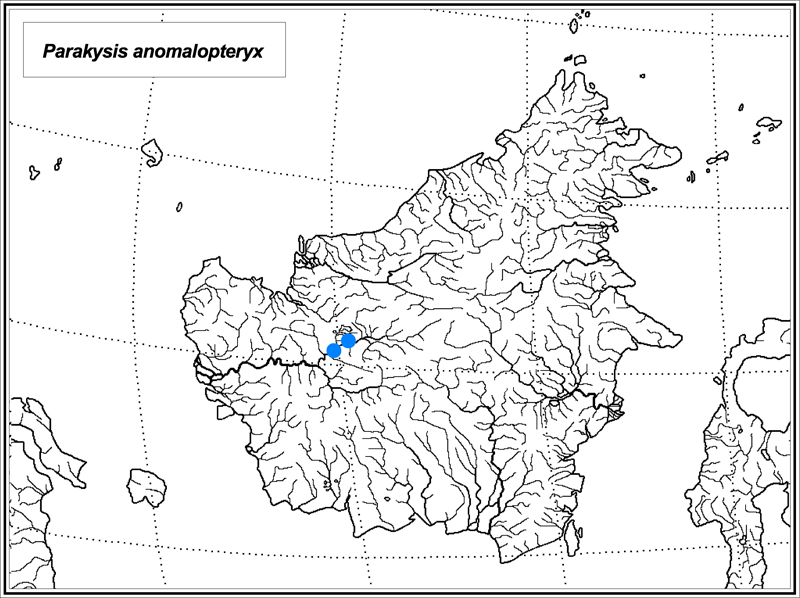
Parakysis anomalopteryx Roberts 1989
Identification: P. anomalopteryx has a broad head with small, subcutaneous eyes. The upper lip lacks a median lobe projecting ventrally between the two lateral lobes of the lower lip; i.e., the lower lip is entire, lacking a median concavity. The outer mandibular barbel lacks branches; the inner mandibular barbel has 1-2 long, slim branches. The mandibular latero-sensory canal has a pore lateral to the inner mandibular barbel. Body tubercles are very small. The dorsal fin has 1 spine and 4 rays; the first ray in the dorsal fin is sometimes branched, the other 3 are always branched. The pectoral fin has 1 spine and 5-6 rays; the outermost and innermost rays are sometimes branched, the 4-6 median rays are branched. The pelvic fin has 5-6 rays; the first 2 rays are simple, the 3-4 median rays are branched, and the last ray is sometimes branched. The anal fin has 8-10 rays; the first 2 rays are simple, the next 2 are sometimes branched, and the last ray is sometimes branched. The caudal fin has 11-12 rays; the upper- and lowermost caudal rays are simple, and the 9-10 median rays are branched. The caudal fin has pointed lobes and lacks secondary branching. There are 30-34 total vertebrae, 17-20 preanal vertebrae, and 13-14 postanal vertebrae. Maximum size = 33 mm SL.
Range: P. anomalopteryx is found in western Borneo in the Kapuas basin in Kalimantan Barat.
Habitat: Woody debris in current of small streams.
Similar species: P. anomalopteryx can be distinguished from other members of the genus by the lack of a lobe on the upper lip and corresponding median concavity on the lower lip, an unbranched outer mandibular barbel, presence of 1-2 branches on the inner mandibular barbel, and absence of a mandibular latero-sensory pore lateral to the outer mandibular barbel. Within the genus, P. anomalopteryx has the smallest and least developed tubercles. P. grandis and P. longirostris have more mottling on the caudal fin and have short, thick branches on the inner mandibular barbels that are not joined at the base. P. grandis has secondary branching of the caudal fin rays in specimens larger than 30 mm SL.
Information from:
Ng, H. H. and K. K. P. Lim. 1995. A revision of the southeast Asian catfish genus Parakysis (Teleostei: Akysidae), with descriptions of two new species. Ichthyological Exploration of Freshwaters 6 (3): 255-266.
Ng, H. H. and M. Kottelat. 2003. Parakysis notialis, a new species of akysid catfish from Borneo (Siluriformes: Akysidae). Ichthyological Research 50: 48-51.
